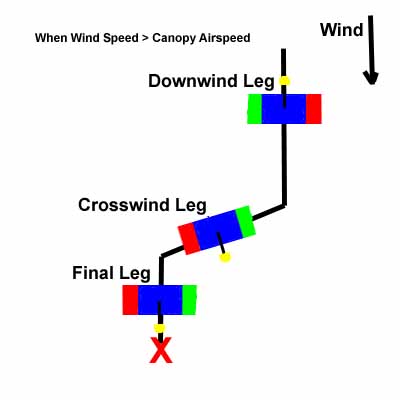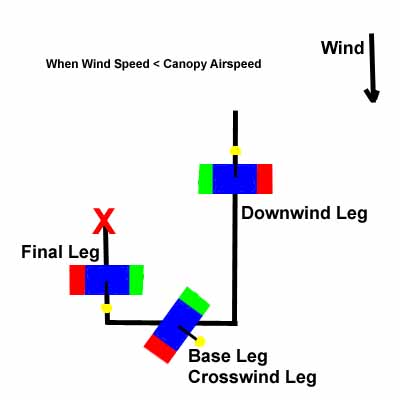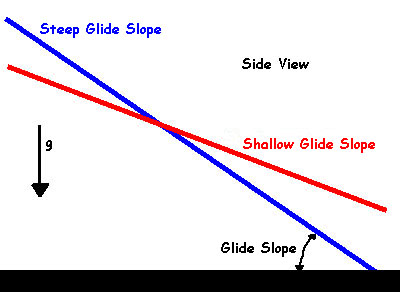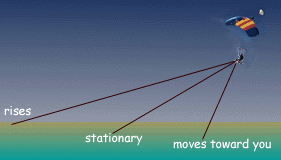- Accuracy Trick
- See Projected Landing Point
- Backing-up Pattern
- Patterns that follow a conventional pattern, but cannot because the wind speed is greater than the canopy's forward speed.

- Canopy Traffic Pattern
- CONVENTIONAL: The airspace from the ground to 1000 ft directly above the landing area plus a 500 foot lateral margin.
SWOOP: The airspace from the ground to at least 1000 ft directly above the landing area plus a 500 foot lateral margin. A canopy with a large recovery arc requires a higher initiation altitude than a canopy with a smaller recovery arc. Larger turns in a high performance maneuver increase the initiation altitude of the maneuver.
- Classic Accuracy Pattern
- A conventional pattern vith a very steep final leg.
- Conventional Pattern
-
Patterns that have a downwind, base and final legs with one of the following:
- only all right hand turns
- only all left hand turns

Patterns that have a straight in approach into the wind with no turns.
- Crab Angle
-
The angle between the track or line of flight and the longitudinal axis of the parachute system.
- Destination Point
- See Projected Landing Point
- Drag
-
The component of the aerodynamic forces that is parallel to the flight path.
- Glide Slope
-
The angle between the horizontal and the glide path of a canopy. Also called glide angle or gliding slope.

- Lift
-
The component of the aerodynamic forces that is perpendicular to the flight path.
- No-OverFly Areas
-
Areas that jumpers are not allowed to fly over below a certain altitude. Typical examples are runways, buildings, packing areas, wind tunnels or other hazards.
- Projected Landing Point
-
There is a point on the ground, in-between the horizon and directly underneath you,
that will appear stationary. That is, it will not rise and it will not move towards your feet.

In the case of backing-up under canopy, the projected landing point will be behind you.
- Sashay
-
A maneuver that offsets the trajectory to the left or right, but maintains the same heading.
- Stationary Point
- See Projected Landing Point
- S-turn(s)
-
A small turn off the original direction of flight followed by another small turn in the opposite direction that puts the jumper back on the original direction of flight.
A series of these small turns creates an S shape in the trajectory.
- Stacked Exits for a High Performance or Classic Accuracy Pattern
-
Several jumpers exit on one pass. The exit order is also the landing order.
Each jumper yields to the jumper in front of them to allow every jumper clear
airspace for their approach.
High performance exits and landings, generally have the highest wing loading
exiting first and pulling slightly lower than the last to exit on a given pass.
Jumpers should know the canopy they follow and where that person will go in the
event of a malfunction.
Both classic accuracy and high performance landings require more attention to the ground than surrounding airspace. Stacked exits and approaches allow jumpers to concentrate on their discipline and maintain adequate separation from others while in the air. - Swoop (aka High Performance) Pattern
-
An approach that includes a speed inducing maneuver that is done to increase the
length of the trajectory that is parallel to the ground and just above the ground
during the final stages of landing. It also increases the airspeed of the final approach.
This may be done with any type of canopy.
Swoop approaches increase a jumper's 'runway', sometimes by hundreds of feet.
These patterns may or may not have all turns in the same direction.
These patterns may or may not have a downwind, base or final legs.
Typical, swoop patterns include:- front riser straight-in approach
- 90° speed inducing approach
- 180° speed inducing approach
- 270° speed inducing approach
- 540° and above speed inducing approach
- Unconventional Pattern
-
Patterns that do not follow a conventional pattern with a downwind, base and final legs.
- Unpredictable Pattern
-
Patterns that do not follow a conventional pattern with a downwind, base and final legs
or standard swoop patterns.
Patterns that have arbitrary spirals or S-turns.
Send your recommendations to JanMeyer_AT_DiveMaker.com (replace _AT_ with @).
All contributions will be considered as PUBLIC DOMAIN.